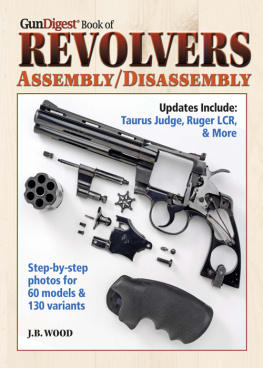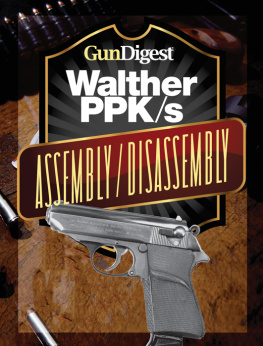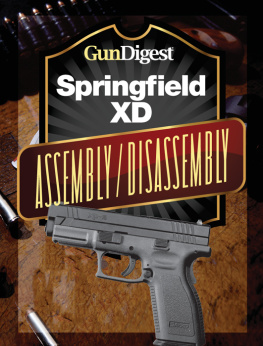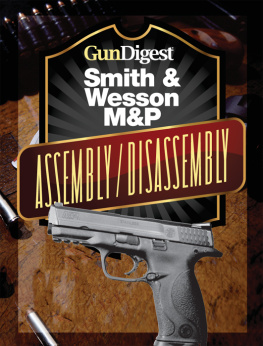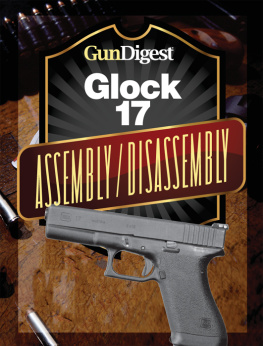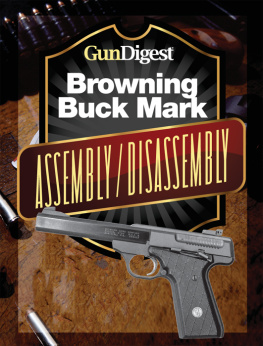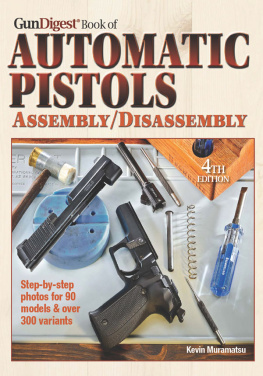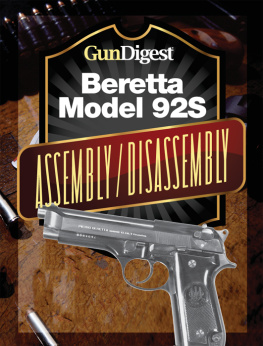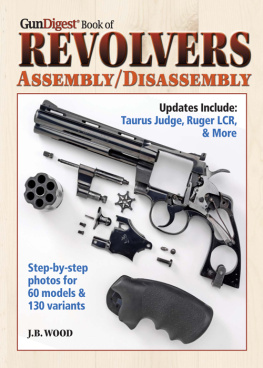GunDigest Book of
REVOLVERS
A SSEMBLY / D ISASSEMMLY

J.B. WOOD
Copyright 2011 F+W Media, Inc.
All rights reserved. No portion of this publication may be reproduced or transmitted in any form or by any means, electronic or mechanical, including photocopy, recording, or any information storage and retrieval system, without permission in writing from the publisher, except by a reviewer who may quote brief passages in a critical article or review to be printed in a magazine or newspaper, or electronically transmitted on radio, television, or the Internet.
Published by

Gun Digest Books, an imprint of F+W Media, Inc.
Krause Publications 700 East State Street Iola, WI 54990-0001
715-445-2214 888-457-2873
www.krausebooks.com
To order books or other products call toll-free 1-800-258-0929
or visit us online at www.krausebooks.com, www.gundigeststore.com
or www.Shop.Collect.com
ISBN-13: 978-1-4402-1452-3
ISBN-10: 1-4402-1452-2>
Cover Design by Tom Nelsen
Designed by Paul Birling
Edited by Dan Shideler
Printed in United States of America
Dedication
This book is dedicated to the late A. D, Jenkins,
one of the last of the old-time gunsmiths.
Acknowledgements
My thanks to these people, who helped to make this book possible.
Sherry Green and Jenny Page, Elizabeth Saunders and the late Robert Saunders of American Derringer, Greg Bond of Bond Arms, Herman Seminiano of HJS Industries, Bill Gentry of Cobra Enterprises, Joseph J. Schroeder, J.T. Ruger and Steve Vogel of Sturm, Ruger & Co., Ron Vogel of F.I.E., Bruce Savane of Taurus, Donna Senecal of New England Firearms, Charles Flint of RG Industries, Frank Nicholson, Rolan M. Bennett, John Yarger of Lock & Load Gun Shop, Dave Ecker of Charter Arms, Glenn Lancaster, E. A. Hurt, Al Paulsen, Harold A. Murtz, Terah L. Flaherty, Eric Brooker, Bill Little, H. E. Rasure, Charles E. Goad, Thomas Brooks Sr., Fred Dewar, Dr. Kenneth M. Eblen, John Morgan and Jim Arcus of Marksman, Police & Shooters Supply, Val Forgett of Navy Arms, Jim Skildum, Doug Evans, and Jeff Blanski of Magnum Research, and Jo Stevens.
Introduction
D uring the years I have been Gunsmithing Editor for two monthly magazines, one of the most frequently asked questions by readers has been, How do I take it apart? When the limited space of a column answer permitted, I gave the routine takedown steps.
In many cases, 1 had to tell the reader that nothing had been published on his particular piece. Occasionally. I recommended (hat the reader try to obtain an instruction booklet from the manufacturer or importer, but this was not always the best answer. In the case of some imported guns, the direct-translation was somewhat humorous to read due to the language gap, or was of little help in actual disassembly and reassembly. In the case of guns no longer made, the instruction sheets are often valuable collector items and are not readily obtainable.
Obviously, something was needed in this area: a book that would cover takedown and reassembly of most of the modern guns, a number of older ones, and some of the tricky aspects of the more well-known pieces. This is the idea behind the book that you have in your hands.
In the area of reassembly, many of the published instructions end with the words, Reassemble in reverse order. In most cases, this may be the only instruction needed and nothing more will be said here. In others, though, this procedure is insufficient. In this book, reassembly directions will seldom be reduced to a single line in order to avoid an embarrassing trip to the gunsmith carrying a box full of parts. I am confident that the reassembly tips given are clear enough to permit the easy reassembly of all the guns covered. The tips do not include each and every step along the way, only the more complicated ones. You shouldnt have any trouble.
There are elements in total takedown that require, in many cases, the special tools and skills of the gunsmith. The very knowledgeable amateur may be able to detail strip certain guns to the last pin, spring and screw, but some mechanical aptitude is necessary. This book is designed for both the average gun person and the professional. While it covers routine field-stripping, it also covers complete takedown and assembly.
For simple takedown, the tools needed will seldom be more than screwdrivers of the proper size. Complete takedown will often require several other tools, some of which are not available at the corner hardware store. For this reason, I am including a section on tools, as well as a list of sources for some of the specialized items.
There are a few general rules to be observed in the takedown of any gun. An occasional rap with a plastic mallet may be necessary to free a tight assembly, but for the most part, no force should be used. Never pry; always wear safety glasses as compressed springs can be dangerous. Never take a gun down outdoors, over tall grass, or indoors over a shag carpet. Read the instructions through, at least once, before you begin.
I assume a certain basic intelligence in the reader, and will not start each set of takedown directions with the repeated advice that the gun must be entirely unloaded. Before you start the takedown of any gun, make a thorough visual check to be sure its empty. Check all chambers in a revolver to be sure they are empty. In this area, any mistakes could be very hazardous to your health, so be certain.
Note that this book contains a number of entries for popular derringers (or deringers, depending on your preference). Though not revolvers per se, these guns are simply too important to ignore. We hope you find their inclusion in this book helpful.
Small mechanical variations are noted on the data page for each revolver, in cases which would cause no takedown or reassembly difficulty. If the difference involves a more complicated procedure, then a separate sequence of photos and instructions is included.
Enjoy!
J.B. Wood
Raintree House
Corydon, Kentucky
Spring 2011
A Note on Reassembly
Most of the revolvers covered in this book can be reassembled by simply reversing the order of disassembly, carefully replacing the parts in the same manner they were removed. In a few instances, special instructions are required, and these are listed with each gun under Reassembly Tips. In certain cases, reassembly photos are also provided.
If there are no special instructions or photos with a particular gun, you may assume that it can just be reassembled in reverse order. During disassembly, note the relationship of all parts and springs, and lay them out on the workbench in the order they were removed. By following this procedure you should have no difficulty.
Tools

Countless firearms, old and new, bear the marks, burrs, and gouges that are the result of using the wrong tools for taking them apart. In the interest of preventing this sort of thing, I am including here a group of tools that are the best types for the disassembly of revolvers. Except for the few shop-made tools for special purposes, all of those shown here are available from one of these two sources:
Brownells Inc.
Next page
